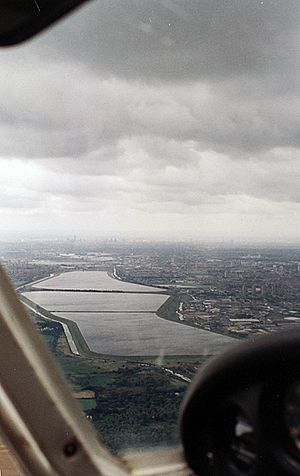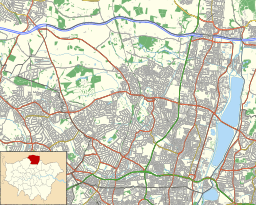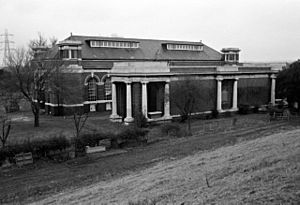King George V Reservoir facts for kids
Quick facts for kids King George V Reservoir |
|
|---|---|

Looking west across the reservoir
|
|
| Location | London Borough of Enfield |
| Coordinates | 51°39′00″N 0°00′58″W / 51.6499°N 0.0161°W |
| Type | reservoir |
| Basin countries | United Kingdom |
| Max. length | 2.58 km (1.60 mi) |
| Max. width | 0.95 km (0.59 mi) |
| Surface area | 170 ha (420 acres) |
| Max. depth | 7.5 m (25 ft) |
| Water volume | 12.45 Gl (2.74×109 imp gal) |
The King George V Reservoir, also known as King George's Reservoir, is a very large reservoir in London. It's located in the London Borough of Enfield. This reservoir is part of the Lee Valley Reservoir Chain. Its main job is to supply London with clean drinking water.
The reservoir is surrounded by different areas. To the east, you'll find Sewardstone and Chingford. To the west, there's Brimsdown and Ponders End. It covers a huge area of about 420 acres (170 hectares). This makes it the biggest reservoir in London. The King George V Reservoir and the nearby William Girling Reservoir are together called the Chingford Reservoirs. They are owned and managed by a company called Thames Water.
Contents
History of the Reservoir

The idea for this reservoir came about a long time ago. It was part of a big plan for the Lea Valley area. This plan was presented to a special committee in 1893. At that time, a company called the East London Waterworks Company was in charge.
However, things changed in 1902. A new law meant that this company, along with seven others, was taken over. They became part of a new group called the Metropolitan Water Board. This board then became responsible for the reservoir project.
Building the reservoir started in 1908. It took four years to finish, opening in 1912. The reservoir was officially opened by King George V himself in 1913. That's how it got its name!
The Metropolitan Water Board managed the reservoir until 1974. Then, another law changed things again. Ownership and control moved to the Thames Water Authority. Later, in 1989, the Thames Water Authority became a private company called Thames Water. They still own and manage the reservoir today.
What the Reservoir Looks Like
The reservoir was created by building a long, continuous wall of earth. This wall is called an embankment. It was built on the flat land next to the River Lea in Chingford.
An earth wall also divides the reservoir into two parts. These two parts are connected by three large pipes called culverts. The outside of the embankment is covered in grass. It has a central part made of special clay called puddle clay. The outer parts are made of gravel and other natural materials.
The top of the embankment is about 10 meters (33 feet) higher than the land around it. This helps to hold the water in.
| What it is | Measurement |
|---|---|
| Tallest part of the embankment | 10 meters (33 feet) |
| Total length of the embankment | 6,532 meters (about 4 miles) |
| Total water it can hold | 12.4 million cubic meters (about 3.3 billion gallons) |
| Surface area (how much space it covers) | 2.168 square kilometers (about 0.8 square miles) |
In the northwest corner of the reservoir, there's an old building. This is the original pumping station. It was built with red brick and Portland stone. Inside, there were five special gas-powered pumps. These pumps were used to move water. In 1970, new electric pumps were put in, making the old ones no longer needed.
Sometimes, the water level in the reservoir needs to be lowered quickly. This is called "emergency drawdown." In 2005-2007, engineers found that the reservoir couldn't lower its water fast enough. So, they installed two large siphon pipes over the embankment. These pipes help to quickly release water into the River Lee Diversion.
Wildlife and Nature
The King George V Reservoir is a very important place for nature. It is part of the Chingford Reservoirs Site of Special Scientific Interest (SSSI). An SSSI is an area that is protected because of its special wildlife or geology.
This reservoir is a major winter home for many wildfowl (like ducks and geese) and wetland birds. Many of these birds come here in large numbers, which is important for their survival. It's also a safe place for wildfowl to shed their feathers in late summer. Over the years, 85 different types of wetland birds have been seen here.
Fun Activities at the Reservoir
The reservoir is a popular spot for birdwatchers. They come to see all the different kinds of birds that visit. It's also home to the King George Sailing Club. People can enjoy sailing on the water.
To visit the reservoir, you used to need special permits and a key from Thames Water. Since 2016, the rules for visiting have been changing.
How Water Gets to the Reservoir
Water flows into the King George V Reservoir from two main sources. These are the New River and the River Lee Diversion.
How to Get There
You can reach the reservoir by car on Lea Valley Road (A110).
If you're using public transport, you can get there by:




